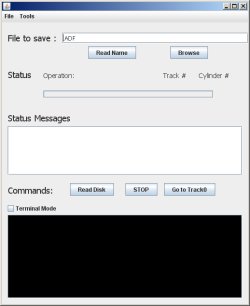Opinions anybody?
9 comments
You may also like
Bug Katcher on Agnus
I swear I already posted about this but heck if I can find the post. Anyways, here’s a photo of a bug katcher installed on Agnus on a Commodore Amiga 500. This gives me the ability to attach a logic analyzer to...
1,642 views
EEVBLOG does a video teardown on the Amiga 500!
Dave just posted this! I’m so glad to see him take this on!
489 views
Visualizing amiga track data with matlab
So looking at a lot of raw data is pretty tough, but matlab handles it with ease. So the above image shows a sample amiga track from a brand new disk, just recently formatted, within the amiga. It is basically as...
1,057 views






Hi,
looks great :>
im about to write a small article about it on amigaweb, do you have anything spesific you think i should add?
-mike
Any hopes of having it write amiga floppies?
Thanks Mike. I’d appreciate it if you’d post a link here so I could read the write-up.
Some features and short term design goals:
*free, free, free
*open source
*Creates standard .adf images of unprotected amiga disks
*platform independent: Released code will be Java. With support for linux and Mac OS X in both hardware(FTDI USB chip drivers support right now) and software(Java with RXTX serial that already supports both)
*runs on current Windows OSs: I see no problem with 2000/XP/2003 support, Vista whenever I get around to upgrading and testing it 🙂
*uses $5.00 regular PC floppy and drive cables. no modifications, no special amiga drives, cables, or connectors
*Prototype board is $10.00 WITH the SX controller
*USB connectivity: no reliance on serial ports, parallel ports, or the normal associated hardware/OS abstraction/protection issues to deal with
*Current ongoing 2007 project: nothing is stale, outdated, and so on.
*ground-up amateur project. I’m definitely NOT an expert, but what I lack in expertise I make up in hard work and refusal to quit.(although I did feel like that many times!!)
I have physically cabled the board for WRITING amiga floppies, so that is definitely a LONG TERM goal. First things first, I want to be able to get a reliable solid fast reading performance working 100%, and then writing is the next logical step.
Java GUI’s are easy enough to move around and modify, so I’m not sweating the lack of a “write button” etc etc.
Note that it is not practical at this point to build it unless you have access to SX programmer, can get samples/buy Ramtron FRAM, etc. I need to make more progress before I’m willing to put together a parts list, schematic, etc. The SX code base is in DIRE need of cleaning up, and won’t be put up in its entirety until I do so. That is the next step after writing/debugging the Java.
Cool! Keep up good work. It is nice to see the project developing and getting more in shape and in functionality.
Perhaps a separate board, not a development one, would be handy, saving people the need in soldering, programming SX etc. Or an external floppy packed with either board in one case maybe?
Writing floppies will be easier I think. It will be your board to command the floppy, no need to hunt those pulses, fronts, time intervals etc.
Nice, sounds good. Hope you get it working, Writing to the floppy might be a tough nut tho, i know some pc floppy drives can be modified to work with the Amiga atleast.
I’ll prolly write the article a bit later, but the adders is https://amigaweb.net
Good luck with development.
-Mike
Most of the type of problems that you’ve seen are CONTROLLER problems. Whether in software or hardware.
Since I’m handling the controller portion all on my own, a normal PC drive can handle reads and writes for variety of different formats(most 3.5″, 300rpm, low density or high density), including PC and the Amiga formats.
Thanks.
Looks good to me. This is a project I’m looking forward to building and using. Once you have a schematic up, perhaps someone can design a PC layout for it. That will probably make it smaller and more accessible for others to replicate.
I intend on doing the schematic, PCB layout, etc etc myself. I’ve played around with various packages(Eagle, Protel, a few others) and that’s obviously down the road from where I’m at.
You know, the actual hardware aspect of it is really simple. Connect a bunch of leads from the IDC34 to ports on the SX28. Connect memory to SX28 ports. Connect USB to ports. Connect gnd to gnd and pwr to pwr. 🙂
Which reminds me, I’ve got order some right-angle header pins for debugging/my logic analyzer.
I’ve put up a list of all the CAD software I’ve ever heard of that still seems to be actively supported.
I like using Protel.
I just installed gEDA and plan to play with it for a while.
—
David Cary